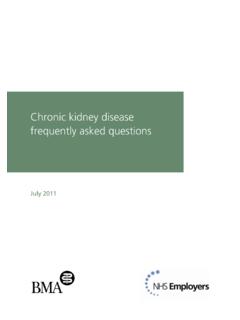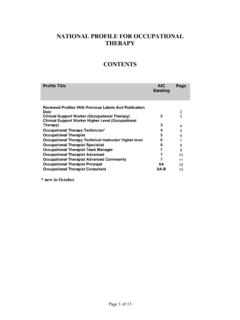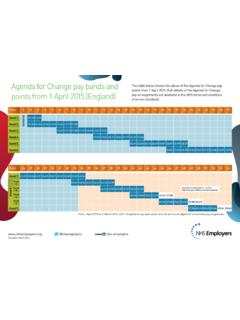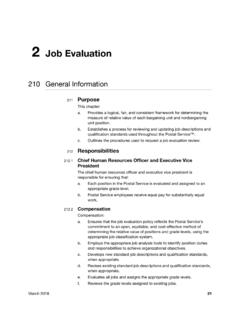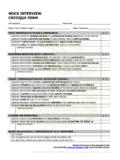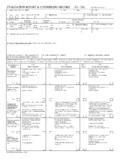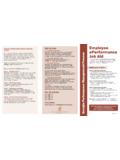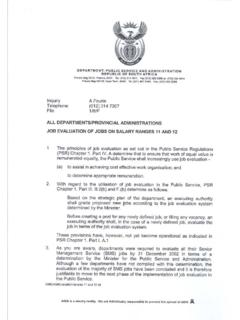Transcription of NHS Job evaluation handbook - Home - NHS Employers
1 NHS Job evaluation handbook Fourth edition, July 2013. NHS Job evaluation handbook Contents The contents of this handbook have been agreed in partnership by the NHS Staff Council 1. Introduction to Job evaluation 3. 2. The status of additional guidance 9. 3. Mainstreaming Job evaluation 11. 4. Merger and reconfigurations of health service organisations 15. 5. Factor plan and guidance notes 19. 6. Job evaluation weighting and scoring 71. 7. Job evaluation weighting scheme scoring chart 73. 8. Job evaluation band ranges 74. 9. Guide tothe use of profiles 75.
2 10. Job descriptions and Agenda for Change 79. 11. Matching procedure 81. 12. Hybrid Matching/ evaluation Procedure 90. 13. National protocol for local evaluations 92. 14. Consistency checking 98. 15. Blocked local matching/ evaluation /consistency checking 103. protocol 16. Glossary 105. 2. 1. Introduction to Job evaluation 1. Overview of contents This version of the Job evaluation (JE) handbook incorporates NHS Staff Council advice which has been published since the second edition of the handbook , as well as the factor plan and procedures to implement job evaluation (JE) in your organisation.
3 In this first introductory section, the text is either in bold or non-bold: bold is used for the tools for carrying out the matching/ evaluation processes non-bold is used for associated advice from NHS Staff Council to cover a number of possible scenarios. Chapter 1 provides the background to the JE scheme. Chapter 2 contains advice on the status of guidance approved by the NHS Staff Council, professional bodies and staff side organisations and whether advice is mandatory or advisory. Chapters 3 and 4 contain essential guidance for future use of the scheme in a changing NHS, either when roles are new or change, or when the service is reconfigured.
4 Chapter 5 contains the factor plan and important guidance notes on how to apply it. Chapters 6, 7 and 8 have information on the weighting and scoring of the scheme and the band ranges. Chapter 9 explains the development and use of national job profiles and chapter 10 gives the NHS Staff Council advice on job descriptions and Agenda for Change (AfC). Chapters 11, 12 and 13 describe in detail the job matching, hybrid matching/ evaluation and job evaluation protocols, and chapter 14. reinforces the importance of the consistency checking process.
5 Finally, chapter 15 sets out the NHS Staff Council procedure on what to do if one of the evaluation processes become blocked at a local level. 2. The background on NHS pay structures before Agenda for Change Collective bargaining arrangements and associated pay structures have changed relatively little since the creation of the National Health Service (NHS) in 1948 until the introduction of AfC in 2004. NHS Job evaluation handbook 3. Pre October 2004, in line with industrial relations practice in the public sector in the immediate post-war period, there was an over-arching joint negotiating body for the sector, the General Whitley Council, and more than 20 individual joint committees and subcommittees for the different occupational groups, each with responsibility for its own grading and pay structures, and terms and conditions of employment.
6 There had been some developments, mainly from the early 1980s onwards, in response to increasing tensions within the system, for example: Reviews of individual grading structures. The most well known of these (largely because of the high number of appeals generated) was the introduction of the Clinical Grading Structure for nurses and midwives on 1 April 1988, which brought in the previous grades A to I. There were other grading structure reviews in the late 1980s and early 1990s which covered professions including estates officers, speech and language therapists and hospital pharmacists.
7 There was no attempt to undertake cross-Whitley Committee reviews. The introduction of independent pay review bodies for doctors and dentists (1971), and nursing staff, midwives, health visitors and professions allied to medicine (1984). These took evidence from all relevant parties and recommended annual pay increases. They replaced the traditional collective bargaining approach, which was considered to have delivered unsatisfactory pay levels for some key public sector groups, but had no remit to compare pay from one group to another (even among their remit groups).
8 Staff groups not covered by pay review bodies continued to use collective bargaining on pay increases but these increasingly mirrored the pay review body settlements. Changes to health service legislation from 1992. These changes allowed organisations to develop their own terms and conditions and to apply these to new and promoted employees, although existing employees could choose to retain their Whitley terms and conditions. Most trust terms and conditions shadowed the relevant Whitley arrangements in most areas, but a small number of trusts introduced totally new pay and grading structures, and other terms and conditions.
9 These were generally based on the various commercial job evaluation systems available at the time eg Medequate, Hay. By the mid-1990s this resulted in a mixture of pay and grading systems, with some significant defects: Difficulty in accommodating developing jobs, such as healthcare assistants, operating department practitioners (ODPs), and multi-disciplinary team members, who might be carrying out similar roles, but whose salaries could vary significantly, depending on the occupational background of the jobholders. NHS Job evaluation handbook 4.
10 Inability to respond quickly to technological developments and changes to work organisation, even where everyone agreed they were desirable. Inability to respond to external labour market pressures, causing severe recruitment and retention problems in some areas. Additional increments, which could be applied flexibly to meet such pressures, were introduced into a number of the major Whitley structures, but these were insufficient to solve the problems. From a union perspective, the Whitley system was viewed as having delivered low pay compared with other parts of the public sector and unequal pay between the various Whitley groups.






